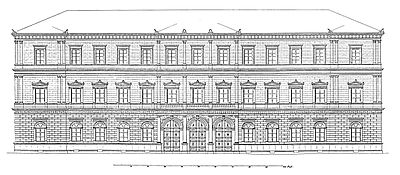
Search
Herzog-Max-Palais

Herzog-Max-Palais was a neoclassical palace at Ludwigstraße 13 in Munich, Germany. It belonged to the House of Wittelsbach and was built from 1828 to 1830 for Duke Maximilian Joseph in Bavaria, father of Empress Elisabeth of Austria.
In 1937, the palace was destroyed by the Nazi Party in order to widen the Ludwigstraße. The successor construction was started in 1938 by Heinrich Wolff for the Reichsbank and was completed in 1951 for the Deutsche Bundesbank.
History
Herzog-Max-Palais filled a block of the Ludwigstraße between the former Frühlingsstraße (now Oskar-von-Miller-Ring) and the Schönfeldstraße (now Rheinbergerstraße).
The three-story building was built from 1828 to 1830 according to a design by Leo von Klenze for Archduke Karl Ludwig of Austria's brother-in-law Duke Maximilian Joseph in Bavaria. Klenze was also involved in the furnishing of the home, involving artists Wilhelm von Kaulbach, Clemens von Zimmermann, and Robert von Langer, as well as sculptor Ludwig Michael Schwanthaler.
Duchess Elisabeth in Bavaria, later the Empress of Austria, was born in the palace on 24 December 1837.
In 1937, the palace was destroyed as part of the Nazi Party's urban redevelopment plan, and Heinrich Wolff began building a neoclassical building for the Munich branch of the Reichsbank in its place. The building was completed in 1951 by Carl Sattler and today houses the headquarters of the Bundesbank in Bavaria.
German architect Erwin Schleich described Herzog-Max-Palais as "probably the most beautiful aristocratic palace that Leo von Klenze ... erected."
References
Text submitted to CC-BY-SA license. Source: Herzog-Max-Palais by Wikipedia (Historical)
Langue des articles
- anglais (english)
- français (french)
- espagnol (spanish)
- portugais (portuguese)
- italien (italian)
- basque
- roumain (romanian)
- allemand (german)
- néerlandais (dutch)
- danois (danish)
- suédois (swedish)
- norvégien (norwegian)
- finnois (finnish)
- letton (lettish)
- lituanien (lithuanian)
- estonien (estonian)
- polonais (polish)
- tchèque (czech)
- bulgare (bulgarian)
- ukrainien (ukrainian)
- russe (russian)
- grec (greek)
- serbe (serbian)
- croate (croatian)
- arménien (armenian)
- kurde (kurdish)
- turc (turkish)
- arabe (arabic)
- hébreu (hebrew)
- persan (persian)/farsi/parsi
- chinois (chinese)
- japonais (japanese)
- coréen (korean)
- vietnamien (vietnamese)
- thaï (thai)
- hindi
- sanskrit
- urdu
- bengali
- penjabi
- malais (malay)
- cebuano (bisaya)
- haoussa (hausa)
- yoruba/youriba
- lingala
Quelques articles à proximité
Owlapps.net - since 2012 - Les chouettes applications du hibou
